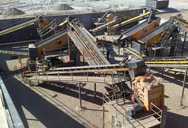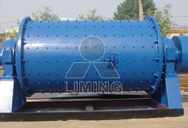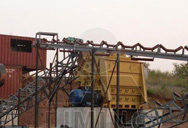


2021-6-21 Gold Recovery. Gold recovery comprises similar stages to the processing of most ores. First, the valuable minerals are separated from the gangue through concentration. The final concentrate is obtained by repeated processing and is
Read More
Gold Recovery 101 Gold can be found in Free-Milling Gold Gold ore is considered free-milling when over 90% of the gold can be recovered by a conventional gravity-cyanidation process with low reagent consumptions at a grind size of 80% passing 75 µm. Figure 2: Typical sulfide-associated gold process . Gold processing 101 - Mining Magazine
Read More
Refractory Gold. The last type of gold deposit is called refractory gold, and it is the most difficult type to extract. It can be defined as any ore that responds poorly to a conventional gravity-cyanidation process
Read More
Gold Recovery from Solution The common processes for recovery of the solubilized gold from solution are (certain processes may be precluded from use by technical factors) [5,6]: Carbon Adsorption Merrill-Crowe process Electrowinning Ion-exchange/Solvent Extraction (i) Carbon Adsorption The process known as carbon in pulp, or charcoal in pulp or ...
Read More
2015-9-15 This page offers a comparative review of gold recovery methods: Flotation and Leaching of the Float Conc. Flotation and Leaching of the sulfide-free Float Tails. Gravity Gold Concentration followed by Flotation and Leaching of the Float Conc.
Read More
2020-11-1 An alternative to conventional recovery processes for gold (i.e. carbon adsorption, ion exchange, and solvent extraction) has been developed recently, namely the electrodeposition-redox replacement (EDRR) method for selective gold recovery from cupric chloride leaching solutions (Lundström and Yliniemi, 2017, Korolev et al., 2019, Korolev et al., 2018, Yliniemi et al., 2018b)
Read More
2021-4-1 In this study, A novel method for gold recovery from refractory gold ore was proposed with the purpose of improving recovery efficiency of gold and reducing environmental pollution. The method consisted of two stages roasting for arsenic and sulfur removal, gold recovery by thiourea leaching, followed by an enhanced chlorination roasting for gold recovery in the presence of pyrite.
Read More
2021-5-27 The gold slurry process of the carbon slurry method (CIP and CIL) is to put activated carbon into cyanide ore slurry, adsorb dissolved gold on activated carbon, and
Read More
2016-1-1 The process has four primary steps: (1) SX recovery of copper–cyanide complexes from leach solutions using LIX 7950, (2) stripping of copper from the loaded organic using a high-pH, copper–cyanide-rich spent electrolyte, (3) membrane-cell electrolysis of the strip solution to produce metallic copper and free cyanide for subsequent recovery, and (4) cyanide recovery from a bleed
Read More
Refractory Gold. The last type of gold deposit is called refractory gold, and it is the most difficult type to extract. It can be defined as any ore that responds poorly to a conventional gravity-cyanidation process with examples including copper porphyry, complex
Read More
gold ore recovery process Gold processing 101 - Mining Magazine. Gold extraction - Wikipedia. Gold Recovery Correctly : 12 Steps - Instructables. Gold fingers are typically found on PCI cards, ISA cards, or on Memory sims/dimms/etc. They create the corrosion free
Read More
Gold Recovery from Solution The common processes for recovery of the solubilized gold from solution are (certain processes may be precluded from use by technical factors) [5,6]: Carbon Adsorption Merrill-Crowe process Electrowinning Ion-exchange/Solvent Extraction (i) Carbon Adsorption The process known as carbon in pulp, or charcoal in pulp or ...
Read More
A process and system for recovery of gold from an ore having the steps of i) providing the ore containing the gold to be recovered, ii) leaching the ore in an oxidative chloride medium, including a nitrogen species to produce a solution comprising gold; and iii) recovering the gold from the solution.
Read More
2015-9-15 This page offers a comparative review of gold recovery methods: Flotation and Leaching of the Float Conc. Flotation and Leaching of the sulfide-free Float Tails. Gravity Gold Concentration followed by Flotation and Leaching of the Float Conc. Heap Leach amenability (cyanidation CIL) after coarse crush. Whole ore
Read More
2006-12-5 In 1970, an oxidation treatment based on hypochlorite was developed to increase the recovery of gold from carbonaceous gold ores by cyanidation. In the early 1950's, attempts were made to employ carbon-in-pulp technology to recover gold from ores, but the fixed price of gold
Read More
are driven by the gold recovery rate. The pre-treatment of refractory gold ore should increase the gold recovery rate in the cyanide leach process by 30-40% in order to be economical” “Large operations tend to choose roasting or pressure oxidation, while smaller operations tend to select bacterial leaching,” says Dr Fleming. “Other
Read More
2017-9-7 An ore containing 1% sulphur will produce a mass pull of approximately 5% by weight to a bulk flotation concentrate where recovery is the key driver. If this ore also contains 1g/t Au (for GSR =1), and 90% recovery to concentrate is achieved, then 0.90g will be recovered and with a concentration ratio of 20 (5% to concentrate) this corresponds ...
Read More
Cyanide Process. Cyanide process is also called as Macarthur-forest Process. It is the process of extracting gold or silver from the ores by dissolving in a dilute solution of potassium cyanide or sodium cyanide. This process was introduced in the year 1887 by the Scottish chemists naming Robert W. Forrest, John S. MacArthur, and William Forrest.
Read More
Gold Mining Process, Gold Recovery Process, Gold Under the new situation, Xinhai Mining has paid long-term attention to gold ore dressing process, technology and equipment research development. After 20 years of continuous studies, according to the different types of gold ore characteristics and user requirements, Xinhai has formed three gold ...
Read More
Gold Recovery from Solution The common processes for recovery of the solubilized gold from solution are (certain processes may be precluded from use by technical factors) [5,6]: Carbon Adsorption Merrill-Crowe process Electrowinning Ion-exchange/Solvent Extraction (i) Carbon Adsorption The process known as carbon in pulp, or charcoal in pulp or ...
Read More
2020-7-17 The principle of the alluvial gold mining process is to recover gold and all kinds of associated heavy minerals from raw ore as much as possible by the gravity dressing method. The lower limit of the particle size of gold recovery by gravity
Read More
2009-1-1 Plattner process, gold was dissolved into chlorine water (i.e., water saturated by chlorine gas) while bromine water was also mentioned. It was the first hydro- ... cyanidation or in the aqua regia process used for the recovery of secondary gold from electronic and precious scraps, the lixiviant and the reagent are both highly hazardous ...
Read More
2017-9-7 An ore containing 1% sulphur will produce a mass pull of approximately 5% by weight to a bulk flotation concentrate where recovery is the key driver. If this ore also contains 1g/t Au (for GSR =1), and 90% recovery to concentrate is achieved, then 0.90g will be recovered and with a concentration ratio of 20 (5% to concentrate) this corresponds ...
Read More
2017-9-7 type of ore is characterised typically by sulphide-based minerology (e.g. pyrite or arsenopyrite-based ores) or by fine gold particles that are trapped inside a silica-based mineral. In these cases, roasting and/or fine grinding of the ore is required to expose the fine particles to the leaching solutions. A second major cause
Read More
2020-8-28 the ore for aurocyanide in solution, although when no cyanide was present the kinetics of the two processes governed the distribution of gold between the ore and the carbon. Gold was found to reduce at the chalcopyrite surface and a mechanism for this reduction was proposed. For pyrite, a combination of reduction and physical
Read More
2017-1-18 The Amalgamation Process that employed mercury in the recovery of gold from the ore is no longer used at most major mines, but gold-rich ore often has some traces of mercury that may still stick to gold even after the precipitation and the leaching process. If not removed from the ore
Read More
Cyanide Process. Cyanide process is also called as Macarthur-forest Process. It is the process of extracting gold or silver from the ores by dissolving in a dilute solution of potassium cyanide or sodium cyanide. This process was introduced in the year 1887 by the Scottish chemists naming Robert W. Forrest, John S. MacArthur, and William Forrest.
Read More
